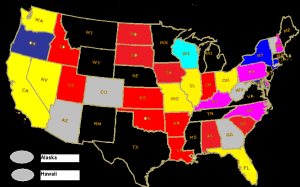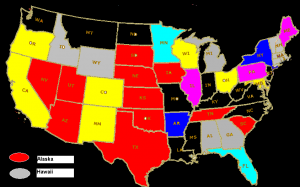2010 Election Predictions – How we rank individual races
Our calls on individual races are based on a composite of polls conducted over the last 28 days (we will compress this “look back period” once primary season has concluded) using the following criteria:
(1) Safe Democratic (dark blue on the map)/Safe Republican (dark red on the map) – either a candidate leads by 10 or more points, or a candidate has over 50% in polls;
(2) Lean Democratic (light blue on the map)/Lean Republican (light red on the map) – a candidate leads by 3-9 points;
(3) Tossup (yellow) – a candidate leads by less than 3 points;
(4) No data available/primary has not been held (gray) – In general, we don’t analyze statewide polls until its primary has been conducted, However, since pollsters have been releasing multiple polls with different Democratic/Republican matchups for states that have not held their primaries, we will modify this rule. Therefore, if at least one of the major parties has a clear front runner in a contested primary, we will use the various poll matchups to get a sense of how a Senate/Governor race is leaning and, based on that composite of polls in the last 28 days, will assess which party is ahead.
(5) No Senate/gubernatorial race in 2010 for this state (black);
2010 Election Predictions – Senate Races
(7/22 projection: 55 Democrats, 45 Republicans, or Republican gain of +5)
(7/14 projection: 55 Democrats, 45 Republicans, or Republican gain of +4)
(7/1 projection: 54 Democrats, 46 Republicans, or Republican gain of +5)
Since our last analysis, we now have polls we can analyze for Connecticut, Delaware, Idaho, New Hampshire, New York, and Wisconsin. We also have yet another Senate race: in West Virginia, a special election has formally been set for November to replace the late Senator Robert Byrd. The state’s Democratic governor Joe Manchin starts off the favorite, although he has primary opposition he must deal with on August 28.
Our estimate of Republican pickups has also changed, as there have been three changes in our poll ratings. Delaware enters our analysis as “leans Republican”, and recent polling suggests that Pennsylvania can be moved from “Tossup” to “leans Republican.” We are also, in light of two recent favorable polls, moving Nevada from “leans Republican” to “Tossup”, as a barrage of negative ads from Senator Harry Reid’s ample war chest has succeeded, for now, in depressing his opponent’s poll numbers.
2010 Election Predictions – Governor’s Races
(7/22 projection: 29 Republicans, 21 Democrats, or Republican gain of +5)
(7/14 projection: 31 Republicans, 19 Democrats, or Republican gain of +7)
(7/1 projection: 29 Republicans, 21 Democrats, or Republican gain of +5)
Since our last analysis, we now have polls we can analyze for Alaska, Colorado, Minnesota, Nebraska, New York, and Wisconsin. We have also decreased our estimate of Republican gains from 7 to 5, as recent polling in Minnesota and Florida shows the Democrats in those Republican held states with narrow poll leads. There are several factors which have led to these reclassifications: (1) in Florida (August 24 primary), the Republican primary has steadily gotten nastier, and as a result, the Democratic candidate’s “lead” is due to her getting 35% in recent polls, while a third party candidate is pulling 15%, and 24% are currently undecided; (2) in Minnesota (August 10 primary), a third party candidate is pulling 11% of the vote, while the Democrat is at 39%. Furthermore, the Republican candidate hurt himself recently with recent remarks he made that minimum wage for waiters may need to be lowered because, with their tips, they can make over $100,000 a year.
While the Minnesota and Florida poll numbers currently look good for the Democrats, it’s also worth noting that we have moved the Texas Governor’s race from “leans Republican” to “solid Republican.” And there are currently seven governor’s races we have rated as “tossup”, of those seven, six are held by Democrats.
Battle for Congress and Governor – House Races
(7/22 projection: 258 Republicans and 177 Democrats, or Republican gain of +79 – 17 Democrats on the “watch list”)
(7/14 projection: 261 Republicans and 174 Democrats, or Republican gain of +82 – 14 Democrats on the “watch list”)
(7/1 projection: 260 Republicans and 175 Democrats, or Republican gain of +81 – 6 Democrats on the “watch list”)
We had remarked in this post that while we are using theoretical criteria to estimate the change in partisan composition of the House, there is an even more important criteria: actual poll results as they become available. In the last week, polls have been released that show three incumbent Democrats previously classified by us as vulnerable with leads in the polls. However, all three are polling under 50% (in fact, two are polling in the low 40s, and one is polling at 46%), so we are moving these incumbents to the “watch list”: Dave Loebsack (D-Iowa), Dina Titus (D-Nevada), and Baron Hill (D-Indiana). Incidentally, all three Democrats voted for healthcare reform at least once.
However, while we are moving these Democrats to the “watch list”, there have also been polls released that confirm our “vulnerable” assessment of three incumbent Democrats: (1) Two term incumbent Gabrielle Giffords (D-Arizona) trails 45-44%, (2) 26 year incumbent Paul Kanjorski (D-Pennsylvania) trails the same opponent he narrowly defeated in 2008 by a whopping 57-36%, (3) freshman Tom Perriello (D-Virginia) was elected by less than 1,000 votes, and currently trails his Republican opponent 58-35%.
2010 Election Predictions – Generic Congressional Vote
(7/22 poll composite: 44.5% Republican, 42% Democrat – +2.5% Republican)
(7/15 poll composite: 45.1% Republican, 42.7% Democrat – +2.4% Republican)
(7/1 poll composite: 44.1% Republican, 42.2% Democrat – +1.9% Republican)
Poll numbers have shown a small but consistent Republican lead in the “generic ballot” question. However, individual polls are showing wildly divergent results: in the last 7 days, for instance, seven polls were taken, with four showing a Republican preference (Rasmussen shows the strongest Republican preference at 45-36%) and three showing more people want a Democrat in Congress (Gallup shows the strongest Democratic numbers – 49-43%).
Final Thoughts
As of today, 27 states have held their primaries, and all states but Delaware have concluded their candidate filing. While this month has been quiet in terms of contested primaries, we are about to enter a bust five week stretch of primary elections, which will temporarily conclude on August 28 when Louisiana holds its partisan Congressional primaries.
John is a political consultant and blogger with JMC Enterprises with expertise in poll sample development and analysis, development of targeted voter files for phone canvassing or mail outs, campaign strategy and demographic consulting, among other things. See his site at WinWithJMC.com for more information.
Advertisement
Advertisement


